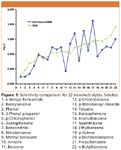Orthogonal Selectivity of ZirChrom®-CARB
Method development in reversed-phase liquid chromatography (RPLC) can be challenging for structurally similar compounds.
Dr. Bingwen Yan and Dr. Clayton McNeff, ZirChrom Separations, Inc.
Method development in reversed-phase liquid chromatography (RPLC) can be challenging for structurally similar compounds. Validation methods often require a column of orthogonal selectivity be used to ensure no impurities are missed, carbon-clad zirconia phase offers dramatically different chromatographic selectivity when compared to traditional silica-based bonded phases. This note shows selectivity comparison of the zirconia based, carbon-clad ZirChrom® -CARB HPLC column versus a typical silica bonded phase for 22 nonelectrolyte solutes with varying chemical properties.
Method development in RPLC has traditionally been difficult for molecules which are geometric isomers or structurally very similar. In bonded-phase silicas, the partition mechanism responsible for retention in RPLC often does not offer adequate chemical selectivity for such compounds. On the other hand, carbon-based phases provide retention in RPLC through an adsorption mechanism which often increases the chromatographic selectivity for these types of compounds and dramatically increases the chances of resolving pairs of these analytes.
In addition to this enhanced and often orthogonal chromatographic selectivity, carbon-based phases also offer increased chemical and thermal stability of the stationary phase. Zichrom Separations, Inc. has developed ZirChrom®-CARB using zirconia as a stationary phase support, and patented chemical vapor deposition technology to produce a carbon-clad stationary phase suitable for use in reversed-phase liquid chromatography. The graphitized carbon surface is extremely resistant to chemical and thermal attack. The authors have run mobile phases at very high pH (1 M NaOH), very low pH (0.5 M HNO3), and at elevated temperature (200 °C) and have not observed loss of stationary phase. This unique chemistry results in a very selective phase with no detectable bleed by LC–MS.
Experimental
22 non-electrolyte solutes were injected onto two HPLC columns of equivalent configuration; 1) ZirChrom®-CARB, 3 µm particle size and 2) a leading traditional silica based bonded phase (ODS), 3 µm particle size. For both HPLC columns the k' for each solute was calculated from the resulting data. Each k' was then converted to log k' and graphed, see Figure 1.

Figure 1
Column: ZirChrom®-CARB, 50 mm x 4.6 mm i.d.
(Part Number: ZR01-0546)
Mobile Phase: 40/60 acetonitrile/water
Temperature: 30 °C with Metalox™ 200-C column heater
Flow Rate: 1 mL/min
Injection Vol.: 5 µL
Pressure Drop: 50 bar
Detection: UV at 254 nm
This method can be tailored to your specific application needs. ZirChrom technical support can help to optimize and transfer this method to your site. Please contact ZirChrom technical support at 1-866-STABLE-1 or support@zirchrom.com for details.
ZirChrom phases offer unique selectivity, high efficiency, and excellent chemical and thermal stability.
Visit www.zirchrom.com for more application notes using ultrastable, high efficiency ZirChrom columns.

ZirChrom Separations, Inc.
617 Pierce Street, Anoka, MN 55303
tel. 1-866-STABLE-1
Email: support@zirchrom.com; Website: www.zirchrom.com

Infographic: Be confidently audit ready, at any time and reduce failures in pharma QC testing
November 20th 2024Discover how you can simplify the audit preparation process with data integrity dashboards that provide transparency to key actions, and seamlessly track long-term trends and patterns, helping to prevent system suitability failures before they occur with waters_connect Data Intelligence software.